PART III.
THE DISEASES OF SHEEP.
The diseases of sheep, says Walley, are usually caused
by an altered condition of the blood, namely, deficiency
in quantity, excess of normal elements, impoverishment
and degradation, depraved condition, &c. Inbreeding is
a predisposing cause of disease. The rams should be
changed every year or two. Fatigue, clipping, and ex
posure to cold wind (sufficient to cause a chill) induce
congestion of the lungs. Sheep can stand almost any
degree of cold alone, but they cannot stand cold and wet
combined. This is especially true of lambs. Cold and
moisture arrest the secretion of the yolk or greasy matter
exuded by the skin, rendering the wool dry and harsh
instead of ‘ greasy.
Avoid overfeeding and sudden changes of food and
management. Also the procreative exhaustion of the
rams and the excessive excitement of the ewes. Also
filthy, decaying, moldy, or frosted (frozen) food and im
pure water. Also overforcing the fattening process, es
pecially with such foods as Waterloo cake, cotton cake,
turnips, and swedes.
The sheep, like the ox, has four stomachs. The fourth
is the true digestive stomach. This complicated digestive
296 THE DISEASES OF SHEEP.
apparatus should be aided, when necessary, by health-
giving foods, such as oats (crushed preferred), bran,
crushed linseed, and ground malt. Corn, beans, peas,
and wheat are good when given in their proper place and
quantity. Also thousand headed or other cabbage. Mut
ton grown on ling and heather is sweeter and more sat
isfying than that of trough or manger-fed sheep. Tur
nips and swedes alone are very bad, especially when filthy.
They produce flesh but no blood.
" I have seen sheep, especially lambing ewes, that have
been fed ad libitum on swedes, without any complemen
tary food, die in dozens, their carcasses laden with fat,
but not a teacupful of blood in the veins of any of them.
In the case of breeding ewes, I have seen the recently
born lambs the subjects of internal dropsies. Again, I
have seen ewes fed in the same way, on swedes which
have been forced with artificial manures, especially phos-
phatic manure, die in dozens from milk fever (so called in
some districts), while their lambs have succumbed to joint-
ill. Prof. Robertson says he has, by way of experiment,
produced these diseases at will.” (Walley.)
THRUSH OR APHTHA
Has a benign as well as a malignant form. The benign
form usually attacks lambs, and the malignant may be
communicated to them by the milk. Both forms are at
tributed to a fungus, the benign to that known as ' oidi-
um albicans.' The benign is short-lived. It is character
ized by a whitish, furred eruption in the mouth, with a
little fever and diarrhea.
The malignant form not only has eruptions in the
mouth, but also on the lips and about the body, with
bleeding ulceration, diarrhea, or dysentery, and even pu
trefactive fever and abscesses about the head and lungs,
constituting pyæmia (purulent contamination of the blood).
Remedy.—Alum, borax, sulphurous acid, chlorine, or
ERYTHEMA, ECZEMA, CARBUNCLE. 297
potassium chlorate solutions locally. Electuaries (confec
tions) of oxymel, glycerine, and water, and glyceride of
starch. Laxatives, salines, hydrargyrum cum creta for
gastric disorder. Tonics. Soft, digestible food.
For doses, see pages 13 to 29.
ERYTHEMA
Is described on pages 157 and 274. If the lambs are
allowed to suck, protect the teats with a gutta-percha
shield ; otherwise they may become very sore. If they
do become sore, place the ewes on a scanty pasture apart
from the lambs. Rub the teats with boric or salicylic
acid ointment night and morning. Cleanse first if nec
essary.
ECZEMA OF THE LIPS
Is usually attributed to the irritation of fine particles
of sand or gravel, aggravated by long-continued wet, but
in some instances it may be caused by indigestion or
stomach irritation, and probably the irritating action of
pollen grain. It is a mild affection, consisting of crops
of small bladders on the lips, with some local inflamma
tion and slight fever. If neglected and its cause be un-
removed, serious results may follow. The lips become
greatly swollen, misshaped, and tender, the skin chapped
and ulcerated. Small abscesses form along the side of the
face and in the lungs, followed by suppuration of the
neck glands. Flesh useless.
Remedy.—Change the pasture, give a little laxative
medicine, and smear some protective agent, such as car-
bolized lard, over the lips.
CARBUNCLE
Is lees frequent than eczema, but is common in lambs,
especially during the autumn months. It is often called
‘ hair and hoof and ‘orf.' Like eczema, it is usually of
a mild character. If neglected, it may lead to deep-
298 THE DISEASES OF SHEEP.
seated inflammation, ultimately causing death by exhaus
tion or blood poisoning. Its cause is not known, but it
may be due to a depraved condition of the blood, as the
result of injudicious management, to irritation of the
stomach and bowels, to a microscopic parasite acting lo
cally, or to a parasitic product, such as ergot, acting sys-
temically.
The disease first appears as a painful, circumscribed
swelling on the coronet or lip, or both. Ulceration of
the skin results, and an angry looking sore, associated
with considerable thickening of the surrounding tissues,
is formed. If properly treated, this sore quickly heals,
but if irritated by dirt or otherwise, it takes on unhealthy
action, spreads, and becomes very intractable. Treat as
for eczema.
ECTHYMA,
Consisting of small, pointed, pustular eruptions, occurs
often in the summer time. It causes very little general
disturbance, and is of little importance except for the
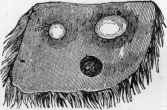
Fig. 136. Ecthyma. Compare with figures 137, 138 (opposite page.)
fact that it may possibly be mistaken for sheep-pox, a
very serious disease. The pustules dry up without leav
ing a scar. The disease is sometimes called acne.
See pages 163, 279 for further information concerning
this disease,
FORMS AND STAGES OF SHEEP-POX. 299
SHEEP-POX (VARIOLA OVINÆ),
Is â contagious, infectious, and eruptive disease, anal
ogous to smallpox and cow-pox ; said to depend on a
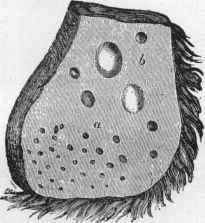
Fig. 137. Sheep-pox. a, the eruptive stage, b, the pustular stage.
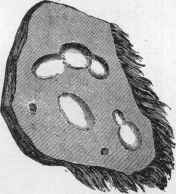
Fig. 138. The Confluent Form (union of two or more pustules).
microbe ; runs a definite course, and as a rule occurs but
once,
300
THE DISEASES OF SHEEP.
There is both a benign and a malignant form. The
malignant form never produces vesicles ; the sheep lose
their eyes ; the wool falls off ; the skin cracks in a zig-
zag manner, and the nostrils become filled with a fetid
discharge. In the benign form genuine vesicles appear,
which, after the scabs fall, leave pits in the skin, on
which the wool never grows again.
According to Prof. Simonds, the disease is not com
municable to the cow or to children. Saccho, however,
says that ' ovination ' is protective against smallpox.
Symptoms.—In 36 to 48 hours temperature rises to
105°, or even 107 or 108°; skin dotted with bright red
pimples ; eyes bloodshot, and in severe cases the lids are
swollen and tears trickle down the face ; breathing quick
and short ; mucous discharge from nostrils, &c.
Remedy.—Isolate healthy and watch them. Good
nursing. Gentle aperients ; salines. Tonics ; stimulants ;
nutritive, digestible food for convalescents. Inoculation
of healthy sheep produces a rather severe and contagious
form of the disease.
MALIGNANT CATARRH
Is often very destructive to hill sheep, especially in bad
seasons. It is very intractable. Beginning apparently as
a simple cold, it is soon followed by destructive - inflam
mation and ulceration of the lining of the nostrils ; these
in turn by abscesses in the glands of the face and throat ;
also in the lungs, and, if the animal lives long enough,
by wasting and diarrhea. The disease is probably caused
by a micrococcus. (Walley.)
Sheep sometimes suffer from simple catarrh, laryngitis,
and bronchitis. (See pages 70, 82, 258 &c.) Verminous
bronchitis is caused by worms in the air tubes. (See
husk.)
A MANGE PARASITE. 301
MANGE, SCABIES, OR SCAB
Is caused by a parasite (Psoroptes ovis). The parasites
cause great irritation and itching. Sheep will rub them
selves against anything. To make sure as to the para-
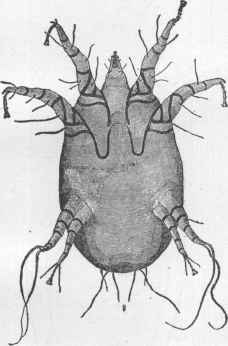
Fig. 139. The mite or acarus known as Dermatodectes ovis. Magnified.
sites, remove a little scurf and examine with a pocket
lens or microscope. If neglected the parasifces will spread
to a whole flock and cause great loss.
Remedy.—Dress with corrosive sublimate, 1 part, com
mon salt, 8 parts, water, 500 parts. Decoction of tobac
co, 1 part, water, 40 parts. Stavesacre decoction—1 part
302 THE DISEASES OF SHEEP.
to 40 of water—with half of which shake up when using
1 part each of wood tar oil and potassium carbonate. Any
of the foregoing, or sulphur, 1 oz.. lard, 1 oz.
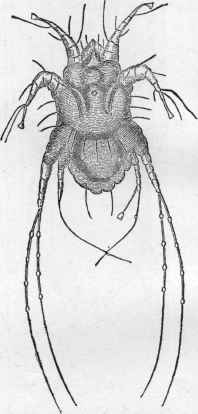
Fig. 140. The mite or acarus known as Sarcoptes ovis, from beneath.
Magnified. Compare with Fig. 141, opposite page.
In all bad cases the sheep should be bare shorn and
the affected parts well soaked with potash lye before the
insecticide is applied. Isolate affected sheep and wash
ANOTHER MANGE PARASITE. 303
racks, rubbing posts. &c., with corrosive sublimate solu
tion.
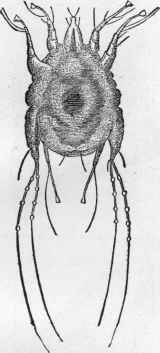
Fig. 141. Same from above.
FOOT-ROT
Is inflammation and ulceration affecting various struc
tures of the foot, and is frequently contagious. (1) Abra
sion of horn ; inflammation of secreting surfaces of sole
or walls, beginning below and extending upward. (2) In
flammation of interdigital structures, with burrowing of
discharges under the horn of inner walls of digits, be
ginning above and extending downward. The latter is
the more contagious form.
304
THE DISEASES OF SHEEP.
Williams says the disease is not contagious.
Remedy.—Remove diseased horn and any irritating
foreign bodies. Dress with mercuric nitrate solution, zinc
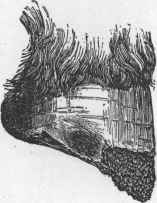
Fig. 142. Confirmed stage of the first form of Foot-Rot.
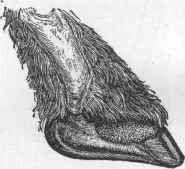
Fig. 143. The condition of the internal wall of the digit in an early
stage of the disease.
chloride, carbolic acid, tar oils, or silver nitrate, the
strength of the dressings being regulated according to
circumstances. Gutta-percha varnish may be sometimes
usefully applied over dressing. Walk sheep through wood
THE DEADLY FLUKE WORM.
305
en trough containing 1 lb. each of arsenic and sodium
carbonate and 50 gallons of water ; or, 1 part copper sul
phate to 50 parts of water. Avoid beans and other forc
ing food. Transfer flock to dry, upland pastures.
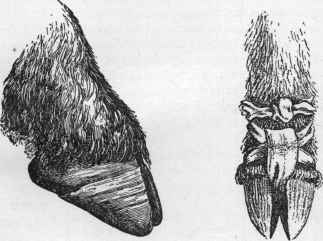
Fig. 144. Foot four weeks after first or Fig. 145. Bandage for
febrile stage. Foot-Rot.
ROT OR FLUKE DISEASE
Is caused by a flat worm known as the fluke (Distoma
hepaticum or Fasciola hepaticum), which inhabits the
bile ducts of the liver, causing extensive inflammation,
from which result various organic changes, such as har
dening and softening, leading in the end to destruction
of its function and, as a result, wasting, lack of blood,
dropsy, diarrhea, and death from exhaustion. When cold
nights follow warm days, many die from congestion of
the lungs as the result of chill.
The worm is seldom more than an inch in length. It
is bisexual (hermaphrodite), and is propagated by eggs,
which are passed out with the bile and the dung in
306
THE DISEASES OF SHEEP.
countless numbers, often lodging on the grass. If they
fall on dry soil, they are harmless ; if on wet soil, the
disease is propagated to other sheep. The egg is oval in
shape, has a lid at one extremity, and contains an em
bryo which, when matured, is provided with delicate,
hair-like processes known as cilia. The lid is lifted, al
lowing the embryo to escape. The latter at once begins
to search for a particular snail (the Limnus truncatulus),
whose body it penetrates by the aid of a boring appara
tus. It undergoes a series of wonderful changes in form,
passing through several generations, until a tadpole-like
creature is produced. Emerging, it encysts itself in the
lower part of the blades of grass, from whence sheep pick
it up in grazing.
Sheep are more susceptible to rot than other animals
simply because they bite closer. A hog-mouthed sheep
escapes ; but many cattle and sometimes, in wet seasons,
colts also suffer.
Rot is never seen on dry lands, nor on salt marshes ;
and even rotting grounds are safe after a frost.
Prevention.—Drain, and thereby kill the snails ; salt
the pastures, and thereby kill both the snails and embryo
worms ; slaughter sheep, mixing their excrements with
lime or salt ; destroy the liyer, intestines, &c., totally.
Isolate sound sheep.
The disease can be detected early by the sheep thriv
ing very rapidly and by the yellow tinge of the membrane
of the eye.
Remedy.—Concentrated, dry food. Common salt and
ferrous sulphate dissolved in water, given daily, mixed
with bran or crushed grain. Slaughter all marketable
sheep.
For doses of .‘furrous sulphate’ (sulphate of iron), see
page 21.
REMEDY FOR DIARRHEA AND DYSENTERY. 307
DIARRHEA
In the lamb is caused by unwholesome milk, cold, grass
(the sudden change from milk to grass), &c.. In severe
cases death sometimes results in 24 hours. Full-grown
sheep also suffer, especially when the new grass comes on
in the spring.
Remedy.—Prepared chalk, 1 oz., powdered catechu, ½
oz., powdered ginger, 2 drams, powdered opium, ½ dram,
peppermint water, ½ pint; 1 to 2 tablespoonfuls morning
and night. A teaspoonful of laudanum and a tablespoon-
ful of rum or gin, well mixed, is good; repeated in half
doses if needed. Also 1½ dram alum in half pint warm
water.
DYSENTERY
Usually appears in hot weather, with excess of moisture,
on rank pastures, and on overstocked and consequently
befouled pastures; in dry summers on lands having
stagnant pools of water, with rank growth of grass around
their borders.
The exact nature of the disease has not been deter
mined yet even in man, but it is believed to be caused
by a fungus. Shepherds entertain such positive views as
to its contagiousness as to lead them to smear tar on the
nose. They had better smear it on the skin under the
tail, or remove the sheep from the contaminated pastures
and apply a top dressing of lime or salt.
Remedy.—If there is any prospect of cure, give an
ounce of castor oil with about 30 drops of laudanum in
a little gruel ; repeat if necessary, or give an astringent
as for diarrhea. Cleanse with warm water and carbolic
acid soap. Dress any sores with carbolic or salicylic acid,
or lard mixed with a few drops of spirit of tar. Tempt
appetite with well compounded gruel.
308 THE DISEASES OF SHEEP.
CARBUNCULAR FEVER (ANTHRAX),
Is caused, says Walley, by a minute, staff-like organism,
termed, from its shape, a bacillus, and belonging to the
class of fission (generative) fungi. It is, on the whole,
the largest of this class of fungi found in animals, and
in the blood streams and tissues multiplies only by fission ;
but when cultivated in proper media, or, what is of more
importance to farmers, when it gains access to suitable
soils, it multiplies rapidly by spores, which by various
agencies find their way on to vegetables grown on such
soils and into drinking water, and produce the disease in
other animals that may partake of the contaminated food
and water.
These organisms, and particularly their spores, possess
a wonderful vitality, and retain their destructive proper
ties for a very considerable period in the earth. Hence
the necessity of utterly destroying every part of the car
cass, the blood, and internal organs of animals which
have died of the disease.
The disease is communicable to man, and is known un
der various designations in many parts of the world.
There is reason to believe that it may be disseminated by
artificial manures, and sometimes even by artificial food,
as it often appears in situations where it has never been
seen before.
Anthrax, which, owing to the dark color of the local
lesions, is compared to a burning coal, is the most deadly
disease of its class. So-called ‘ red braxy ' is often noth
ing more or less than anthrax.
' Blackleg ' is a disease somewhat allied to anthrax, but
the organism that produces it is of a rather different
character, and it is much less virulent.
Remedy.—Free scarification of limited external swell
ings and introduction of antiseptics seem to arrest some
slight cases. Intravenous injection of virus usually in-
WATERY BRAIN CYSTS.
309
sures immunity from attack. Setons produce a condition
of the body less favorable to development of micro-organ
isms. Careful dietary. Removal from exposed, undrained,
infected grazings.
Compare above article with pages 225, 226.
STURDY, GID, TURNSICK,
Also known as turnside, goggles, vertigo, &c, is due to
a bladder worm in the brain. It is called sturdy because
the animal is stupid. A synonymous term in Norfolk,
England, is ‘ dunt.’ If the sheep turns to one side or
round and round, it is known as turnsick, gid, &c., while,
owing to peculiarities of gait, sheep are said to be sailors,
trotters, or swervers. The disease is peculiar to cattle
also.
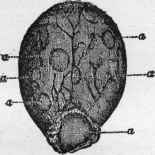

Fig. 146. Brain of sheep, showing hyda-
tids or tapeworm cysts.
Fig 147. Cyst, showing em
bryo worms in various
stages development.
The bladder worm or hydatid is the immature form of
one of the tapeworms of the dog ; possibly also the fox.
It is known as the many-headed hydatid. Sheep become
the victims of it by swallowing the eggs of the tapeworm
while grazing. The embryo finds its way to the brain
either by the circulation or by boring, and sometimes it
gains access to the spinal cord, in the neck, and causes
the condition known as thorter-ill.
310
THE DISEASES OF SHEEP.
Prevention consists in destroying the brain instead of
throwing it to the dogs. Keep dogs as free from tape
worms as possible.
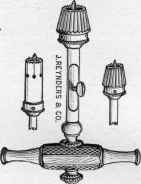
Fig. 148. Large conic Trephine on handle ; small conic on right ; cyl-
indric on left.
Remedy.—Trephine ; remove by trocar. But it is
better to kill the animal as soon as it shows symptoms
of the disease, and make the best of it.
HOOSE OR HUSK,
Scientifically known as verminous bronchitis, a parasitic
disease of lambs and calves, is caused by a round worm
(Strongylus Alarms), which when mature resembles a piece
of white thread. The female, which is larger than the
male, is about l½ to 2 inches long. It inhabits the wind
pipe and bronchial tubes, but its embryos gain access to
the deeper parts of the lungs, causing much irritation
and patchy inflammation. The development of the worm
is not understood. One thing, however, is certain—salt
spread over the contaminated pastures is a preventive.
Drainage is also useful. Destroy the lungs instead of
feeding them to either people or cats. Cooking, however,
kills the worms.
REMEDY FOR WORMS.
311
Many sheep suffering from hoose die from debility in
duced by diarrhea. Others die from suffocation, and many
from congestion of the lungs, if exposed to a chill. Yel
lowish, millet-seed-like knots are found in the lungs of
thousands of slaughtered sheep. They have often been
mistaken for tubercle (consumption), but the microscope
reveals the embryonic parasite in their interior.
Remedy.—Oil of turpentine, given in oil, milk, or
lime water ; it is still more prompt and effectual when
injected into the trachea. Sulphurous or chlorine inha
lations ; spirit of chloroform, swallowed. Liberal, concen
trated dietary. Isolate healthy sheep.
For doses, see pages 13 to 29.
ANOTHER WORM.
Another round worm, the twisted strongyle (Strongy-
lus contortus), is often the cause of great loss among
sheep. It is small, resembles a piece of red thread, and
clings, by aid of barbs, to the membrane of the fourth
stomach. It causes inflammation, diarrhea, wasting, and
death. It is most seen on old pasture land, where there
is plenty of fog for cover. Hence the necessity of remov
ing the fog from such pastures by burning and by chain
harrows. Top dressing with lime or salt should also be
tried.
Remedy.—Chabert's oil, 1 part, oil turpentine, 3 parts.
Kamala in doses of ½ to 1 dram or more, given in thick
gruel or molasses. Potassium picrate, 2 to 10 grains daily
in linseed mucilage.
The only tapeworm of importance found in the sheep
is the ‘ tænia expansa.' But it is questionable if it does
much harm. It is seldom found unassociated with other
parasites.
312
THE DISEASES OF SHEEP.
JOINT-ILL (ARTHRITIS),
Except as a purely sporadic disease, is due to a com
bination of two causes—(1) a depraved or impoverished
condition of the mother's blood—nearly always, in my
experience, brought about by injudicious management—
whereby the milk contracts deleterious properties ; (2)
the combined effects of cold and wet. In some cases the
actual cause is inflammation of the umbilical (navel) vein,
as a result of which abscesses form in the liver. Suppu-
rative inflammation of the joints follows. The probable
primary cause of the disease is a micrococcus. (Walley.)
Lambs from two to five weeks old are very liable to
the disorder. They are often stiff all over before the
swellings appear. Sometimes they crawl on their knees.
Sometimes they are prostrate. Usually they either die or
become incurably lame and worthless.
Remedy.—Keep warm and dry. Mild purges if cos
tive. Cordial medicine in hot gruel. Liniment : Oil of
turpentine, 8 oz., strong solution of ammonia, 3 oz., soft
soap, 4 oz.; digest, shake at intervals, adding water to
make 2 quarts in all. Rub once or twice daily.
RHEUMATISM
Is the same in sheep as in other animals. Treat the
same.
NAVEL-ILL OR NAVEL-POCKING
Is the result (1) of a depraved condition of the moth-
er's system ; (2) the action of poisonous germs on the
clot of blood which is always found in the umbilical vein
of newly born animals. If the system is healthy, no in
jury is caused by septic or poisonous organisms ; other
wise the vitiated blood acts as pabulum for their devel
opment. Septic, sometimes erysipelatous, inflammation is
set up, the products of which becoming absorbed, cause
putrefactive inflammation of the joints, especially those
TREATMENT OF NAVEL-ILL.
313
of the hind limbs. In some cases, however, the inflam
mation extends along the cellular tissue to the fore legs
in a forward direction and to the abdomen, thighs, and
hind legs in a backward direction, the parts soon becom
ing of a black or purple hue from mortification.
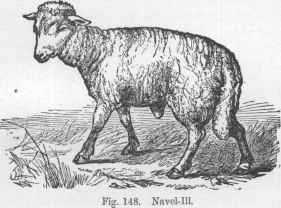
In both joint-ill and navel-ill the condition of the
mother's blood should be improved, and the navel cord
of the lamb should be tied with a silk or cotton ligature
and dressed with an antiseptic lotion or liniment imme
diately after birth. (Walley.)
Aperients or neutral salts, such as sulphite or the sa-
licylate of sodium, for ewes as well as lambs. Feed ewes
very moderately.
LAMBING OR MILK FEVER (METRITIS),
Is probably caused by blood poisoning, blood poisoning
being caused by germs called micrococci. The germs
may be communicated from ewe to ewe by means of the
blood on the hands of shepherds engaged in delivering
ewes. Hence the necessity of disinfecting or washing the
hands with 1 part of carbolic acid to 50 of water, or even
314 THE DISEASES OF SHEEP.
with carbolic soap ; or 3 grains permanganate of potassi
um to 1 oz. of water. The vagina of all infected ewes
should also be washed, and the sick separated from the
well. The disease is due sometimes perhaps to wounds
and the retention and decomposition of the afterbirth.
Remedy.—Siphon or syringe uterus with tepid water
or antiseptic. Remove remnants of placenta or blood
clots ; render any wounds aseptic (non-poisonous). Where
walls of uterus are dilated or flaccid, inject solution of
ergot and belladonna tincture. Rugs wrung out of hot
water over loins and abdomen. Sulpho-carbolates, sul
phites, hydronaphthol internally. If bowels are torpid,
give half dose physic with ginger, gentian and molasses,
and promote effect by laxative injections. Remove urine
by catheter. Generous diet. Tonics, stimulants.
For doses, see pages 13 to 29.
ABORTION, AFTER-PAINS, AND GARGET
Are much the same in ewes as in cows. (See pages
289-291.) Ewes are more easily frightened than cows,
and they are much oftener injured in casting. They
should not be cast when pregnant, nor be roughly used.
They should be carefully watched about the middle period
of gestation. (The full period of gestation is about 150
days.) They should not be overfed and fattened just be
fore lambing, for this is one of the chief causes of after-
pains.
In garget (sore udder), 3 or 4 ounces of Epsom salt
may be necessary, and may be repeated. Foment with
warm water and rub with ointment, &c., as for cows.
LOUPING-ILL OR TREMBLING,
Says Williams, entails great loss among hill sheep every
year. It has been described as a species of ergot intoxi
cation or nervous excitement. There is sometimes squint
ing, at other times convulsive movements of the eyes.
SHEEP TICKS.
315
There are also convulsive movements of the body and
legs, and more or less increase of fluid in the spinal cord.
Veterinarians are not agreed as the cause of the dis
ease, but as good food and pure water are preventives of
it, bad food and impure water must be predisposing causes
of it.
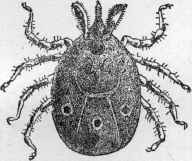
Fig. 149. Sheep Tick.
Louping-ill is only seen on land infested with ticks.
Ticks are the cause of the disease. It is possible, how
ever, to have land infested with ticks and yet have sheep
free of louping-ill, as all ticks do not seem to contain
disease germs.
Improve moors and pastures where it exists. The cure
is uncertain, but many sheep recover.
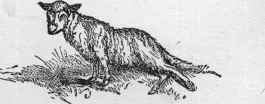
Fig. 150. Louping-Ill or Hydro-Rachitis.
316 THE DISEASES OF SHEEP.
MEASLES
Which consists of red, irregular spots on the chest,
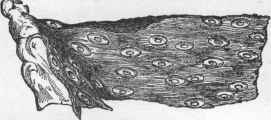
Fig. 151. Measles in pork.

Fig. 152. Same, highly
magnified.
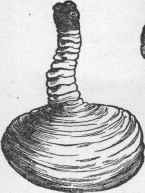
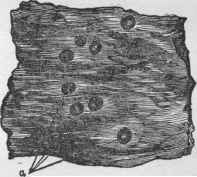
Fig. 153. Slice of roasted sirloin beef.
a, measles divided by knife into
nearly equal parts.
Fig. 154. Measle or Bladder Worm
of beef. Magnified.
thighs, head, and sides, is preceded by slight febrile
symptoms, sneezing, coughing, swelling in the region of
MEASLES TRANSMITTED BY INOCULATION. 317
the head, discharge from the nostrils, hot mouth, dry
skin, constipation, loss of appetite, &c. The skin has a
peculiar odor. The red spots are hard in the center ; if
pressed, they appear white for a time. They seem to do
good, for in about 24 hours after their appearance the
febrile symptoms and swelling of the head subside. The
spots become brownish in four or five days, and disap
pear in about five days more. The skin then peels off.
Some symptoms of catarrh continue. In fatal cases diar
rhea sets in about the ninth day.
We now know that mutton and beef as well as pork
may become measled. These three kinds of measles are
perfectly distinct from each other, and are derived from
different species of tapeworm. (Williams.)
The disease can be transmitted by inoculation. Out of
103 animals inoculated by way of experiment, only 1 died.
Give plenty of water and niter to lick.
HOVEN
Is practically the same in sheep as in cattle (page 238).
Remedy.—Half a pint of linseed oil ; if no relief fol
lows in 2 or 3 hours, give ½ oz. aromatic spirit of am
monia in a pint of warm water, or about 6 oz. of brandy
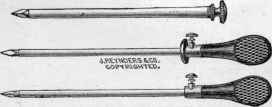
Fig. 155. Trocars.
or whisky, slightly diluted with warm water. Trocar if
necessary, and retain canula as long as there are signs
of distress.
318 THE DISEASES OF SHEEP.
TETANUS (LOCK-JAW),
Is about the same in sheep as in horses and cattle, and
should be treated the same. The animal may die in twelve
hours. Exposure to cold, especially after shearing, is con
ducive of the disease.
Keep warm and quiet. Give gruel, to which add a little
gin. Castor oil or Epsom salt ; repeated if necessary. (See
pages 53 and 234.)
RABIES
Kills sheep in from three to seven weeks. It develops
itself in from two to four weeks after the bite, but it
may remain dormant till the eleventh week. The sheep
gradually grow sick. Sometimes they die of paralysis, at
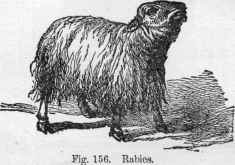
other times of convulsions. They have great thirst, but
no fear of water ; become furious and fight among them
selves, but do not bite mankind. (See page 50.)
SHEEP BOT-FLIES
Are a little larger than ordinary house-flies. They are
of an ashy gray color. They deposit their eggs in the
nostrils of sheep during July and August, where, if not
expelled, they remain till spring. Being then full-grown,
REMEDIES FOR BOT-FLIES, RED WATER, ETC. 319
they fall to the ground and become pupæ. The pupæ-
cases open in summer and they are freed. They deposit
their eggs and live till fall. The maggots penetrate to
the sinuses and sometimes even to the brain.
Remedy.—Snuff, solution of common salt, tobacco in
fusion, diluted vinegar, or a weak solution of turpentine
may be injected into the nose. Many flies will be expelled
by sneezing. If any remain in the sinuses, trephine and
syringe with tepid water containing a small proportion of
carbolic acid.
RED WATER
Kills sheep and lambs as well as cattle. (See page
270.) If the disease is discovered in time, slaughter for
food. It is claimed that the disease is due to a lack of
iron in the system. Whether true or not, salt of iron
seems to be useful. Give 15 grains of sulphate of iron.
OPHTHALMIA (Inflamed Eyes),
Is frequent and sometimes severe in sheep. As a rule
it is the same as in the horse (page 136), but it has
special features. One of these is where the eyelids ad
here to the eyeball, common but not confined to sheep
suffering with scab. Shepherds separate the lid from the
ball by means of a thin, hard, and polished piece of
wood, wash with a decoction of mallows or poppyheads,
and sometimes rub in a little oil.
Sometimes the disease is epizootic—among cattle as well
as sheep. This form is known as ‘ the blind,' and is pe
culiar to young sheep, especially when exposed. It is
dangerous, besides which the blind animal is liable to fall
over a precipice. Apparently it is due to exposure to
cold, but it may possibly be due to a micro-organism.
It is highly infectious.
Remedy.—Dark, well ventilated shed ; nutritious food,
with a lump of rock salt in trough. Tar or ointment of
320 THE DISEASES OF SHEEP.
salicylic acid around margin of eye, renewed in four days.
Rub with a mixture of castor oil and corrosive sublimate,
or blow, with quill, salt dried by heating into the eye.
In diseases of the eyes, in either sheep or cattle, it is
better, when practicable, to fatten and slaughter than to
waste time and money in treatment, especially in such
diseases as amaurosis (glass-eye), glaucoma, &c.
NON-SECRETION OF MILK (AGALACTIA),
When not depending on any disease nor on wasting of
the udder, may usually be restored, or partially restored,
by the use of nutritious food and the following draft :
Powdered aniseed, 2 oz., powdered gentian, 2 oz., in a
pint of warm water or beer, 2 or 3 times daily.
The ears of sheep require to be kept clean, as they
are liable to inflammation from dirt and maggots. The
head is carried lower than usual, often a little to one
side, and is occasionally shaken.
Fractured and Broken Limbs are sometimes cura
ble, but unless the sheep is very valuable, it is cheaper
to slaughter.
But first, if you want to come back to this web site again, just add it to your bookmarks or favorites now! Then you'll find it easy!
Also, please consider sharing our helpful website with your online friends.
BELOW ARE OUR OTHER HEALTH WEB SITES: |
Copyright © 2000-present Donald Urquhart. All Rights Reserved. All universal rights reserved. Designated trademarks and brands are the property of their respective owners. Use of this Web site constitutes acceptance of our legal disclaimer. | Contact Us | Privacy Policy | About Us |